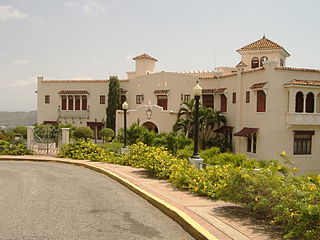
Castillo Serrallés is a mansion located in the city of Ponce, Puerto Rico, overlooking the downtown area. It was built during the 1930s for Juan Eugenio Serrallés, son of businessman Juan Serrallés, founder of Destilería Serrallés. The structure sits on a 2.5-acre (1.0 ha) exceedingly manicured property. Nowadays, the structure functions as a museum, Museo Castillo Serrallés, with information about the sugar cane and rum industries and its impact in the economy of Puerto Rico. It is also increasingly used as a venue for social activities, including destination weddings. The property was listed in the National Register of Historic Places in 1980 and on the Puerto Rico Register of Historic Sites and Zones in 2001. In 1996, the structure was featured in the American TV series America's Castles.

The Capitol of Puerto Rico, also known as Casa de las Leyes(House of Laws), and most commonly referred to as El Capitolio(The Capitol), is the seat of the Legislative Assembly, or the bicameral legislature, composed of the Senate and House of Representatives, responsible for the legislative branch of the government of Puerto Rico. Located on San Juan Islet immediately outside the Walls of Old San Juan, the oceanfront, neoclassical Beaux-Arts-style, entirely white marble-covered edifice was constructed between 1921 and 1929 to resemble the ancient Roman Pantheon in Rome, using as inspiration the Low Memorial Library in New York City. It was added to the National Register of Historic Places in 1977.

This is a list of properties and districts in the southern municipalities of Puerto Rico that are listed on the National Register of Historic Places. It includes places along the southern coast of the island, and on the south slope of Puerto Rico's Cordillera Central.
Rafael Carmoega Morales (1894–1968) was a Puerto Rican architect from Rio Piedras, Puerto Rico. He was the first Puerto Rican to become State Architect, a position within the Department of the Interior which he held from 1921 to 1936. Carmoega was one of the most accomplished Puerto Rican architects of the 20th century.

Barranquitas barrio-pueblo is a barrio and the administrative center (seat) of Barranquitas, a municipality of Puerto Rico. Its population in 2010 was 2,695.

The Edificio Alcaldia, also known as the Antigua Casa Alcaldía de Carolina, is a historic building in Carolina, Puerto Rico. The building was designed by Puerto Rican architect Rafael Carmoega, then an architect of the Department of the Interior, with assistance of Francisco Garden. The Department of the Interior also built the building. In addition to serving as the City Hall, the facilities included government offices, the Municipal Jail, and a Medical Office.
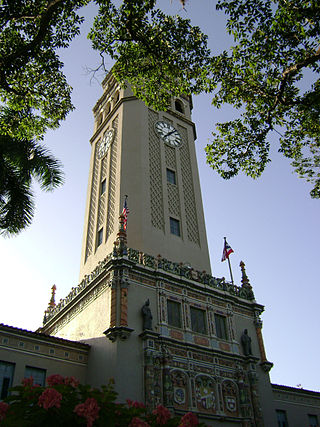
Roosevelt Tower, more popularly known as La Torre, is a 173.54 feet clock tower located above the main entrance to the Baldorioty de Castro Building in the University of Puerto Rico, Río Piedras Campus. The tower is also referred to as El Faro and it is considered a symbol of the University of Puerto Rico and of higher education in Puerto Rico. The tower, along with the main historic quadrangle in campus, have been listed on the National Register of Historic Places since 1984, and on the Puerto Rico Register of Historic Sites and Zones since 2000.
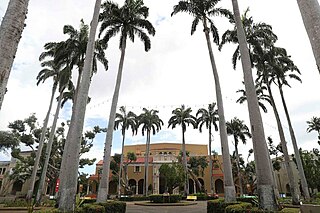
The Quadrangle is the heart and main quadrangle of the University of Puerto Rico, Río Piedras. Together with the Roosevelt Tower, it is listed on the National Register of Historic Places and the Puerto Rico Register of Historic Sites and Zones as the University of Puerto Rico Tower and The Quadrangle, for its unique history which represents the union between Puerto Rican architecture with the Jeffersonian Neoclassical style often seen in American universities. It is famous for its lines of Puerto Rican royal palm or palma real and the architecture of its surrounding buildings.

Casa Córdova, also known as Casa de las Conchas, is a historic building located at 14 Gonzalo Marín Street in the historic center of the Puerto Rican municipality of Arecibo. The historic residence, now a commercial building, was added to the United States National Register of Historic Places on November 17, 1986, and to the Puerto Rico Register of Historic Sites and Zones in 2000.
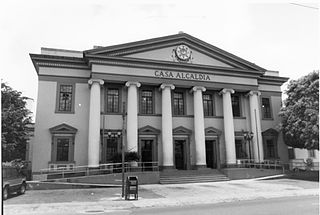
The Old District Courthouse of Humacao is a historic two-story concrete government building constructed in 1925 in the Neoclassical style located in Humacao Pueblo, in the Puerto Rican municipality of the same name. The building was designed by famed Puerto Rico State Architect Rafael Carmoega and built by the Public Buildings Division of the Department of Public Works.

Villa Del Mar, popularly known as El Castillo, is a historic 1917 residence located in Naguabo, Puerto Rico, in the vicinity of the Malecón of Naguabo.
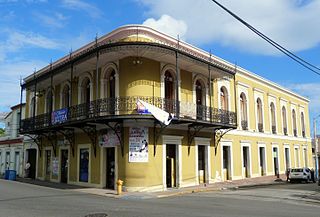
The Antonio Mattei Lluberas Residence, also known as La Casona Césari and the House of the Twelve Doors, is a historic late 19th-century manor house located in Yauco Pueblo, the administrative and historic center of the municipality of Yauco, Puerto Rico. The house was designed by architect Antonio Mattei Lluberas and built in 1893 by Angelo Cesari Poggi of the Césari Antongiorgi family, a Corsican-Puerto Rican family who was important in the development of the sugarcane industry of Yauco and southwestern Puerto Rico.

The González Vivaldi Residence is a late 19th-century historic house located in Yauco Pueblo, the administrative and historic center of the municipality of Yauco, Puerto Rico. The house was built in 1880 in the traditional Criollo vernacular style with elements of Neoclassical and Art Nouveau architecture that was typical to the private residences of wealthy landowners of the region at the time. The structure combines masonry and wood, with well-preserved wooden interiors that have not been altered since its construction. The house was added to the National Register of Historic Places in 1987 and to the Puerto Rico Register of Historic Sites and Zones in 2001.

The Heygler Residence is a historic 19th-century house located in Mayagüez Pueblo, the administrative and historic center of the municipality of Mayagüez, Puerto Rico. The house is notable for its arcade-balcony that is typical of 19th-century urban residences in western Puerto Rico and has been listed in the National Register of Historic Places since 1988. It was also added to the Puerto Rico Register of Historic Sites and Zones.
The Jaime Acosta y Fores Residence, also known as the Doña Delia Acosta House, is a historic vernacular Creole residence located in the historic center (pueblo) of the municipality of San Germán, Puerto Rico. The house was built in 1917 in the traditional Spanish Creole-inspired vernacular style that was popular during the late 19th and early 20th centuries in Puerto Rico. It was designed by architect and engineer Luis Pardo for Jaime Acosta y Fores, a wealthy sugarcane plantation owner who built it for his wife Delia López as a wedding gift. The interior of the house was much less traditional, integrating influences from styles such as Art Nouveau. The structure was added to the National Register of Historic Places in 1990 as it is well-preserved and has suffered no significant modifications throughout the years.
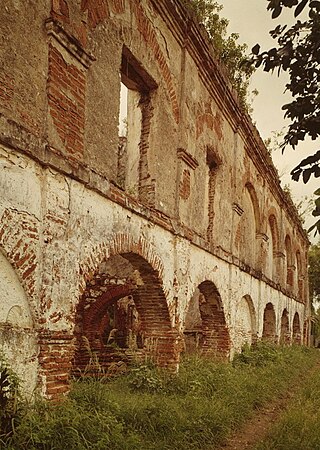
Hacienda Santa Elena is a 500-acre historic sugarcane plantation located in the west bank of La Plata River in the Media Luna area of the municipality of Toa Baja, Puerto Rico. Santa Elena is recognized as a historic monument by the Institute of Puerto Rican Culture (ICP) since 1983, and it was added to the United States National Register of Historic Places in 1992, and on the Puerto Rico Register of Historic Sites and Zones in 2000, as it is the only existing 18th-century industrial complex not only in Puerto Rico but also the Caribbean, in addition to being the oldest existing sugar mill of its kind in the Western Hemisphere.
The Smaine–Ortiz House, also known as the Porfirio Ortiz House, is a historic residence located in Isabel Segunda, the main settlement and administrative center of the island-municipality of Vieques, Puerto Rico. The house is an L-shaped mixed-construction vernacular residential building notable for its ornamented Miami-typed windows and raised gallery balcony. It was built in 1898 by Augustin Smaine, an immigrant from the British West Indies, with later modifications made by its second owner, Don Carlos Ortiz who was a wealthy sugarcane plantation owner during the 19th century. The house was added to the National Register of Historic Places in 1994, and to the Puerto Rico Register of Historic Sites and Zones in 2001.
The Rafael Acevedo House, also called the Mirella Acevedo Sanes House, is a historic residence located in the town of Isabel Segunda, the largest settlement in the Puerto Rican island-municipality of Vieques. It was designed and built in 1900 by Pedro Peterson, a local engineer and master builder. The residence was added to the National Register of Historic Places in 1994 and to the Puerto Rico Register of Historic Sites and Zones in 2001 for being the best-preserved hipped-gable house in Vieques and for being a superb example of the vernacular trends that represent the result of different architectural imports from the British and French West Indies into the Spanish Caribbean.

The Berta Sepúlveda House is a historic residence located in Sabana Grande Pueblo, the administrative and historic center of the municipality of Sabana Grande, Puerto Rico. It was designed by Mayagüez-native self-made architect Rafael Bofill and built between 1926 and 1927 in a traditional vernacular style with elements inspired by the newly emerging Modern architecture, particularly the Prairie-style. Its most distinctive feature is its wide curved balcony with its Tuscan-style columns. It was added to the National Register of Historic Places in 1994 and on the Puerto Rico Register of Historic Sites and Zones in 2000.

Edificio del Valle is a historic mixed-use building located at 1118 Ponce de León Avenue of Santurce in San Juan, Puerto Rico. It was built in 1941 by the Santurce Development Company and designed by famed Puerto Rican architect Rafael Carmoega, who also designed famous buildings such as the Capitol of Puerto Rico and the University of Puerto Rico clock tower among others. It is a five-story reinforced concrete structure with commercial and retail spaces on its ground level and 16 apartments in the rest. Edificio del Valle has a distinctive Spanish/Mission Revival-style, evident in many of Carmoega's works, with eclectic elements that reference both the local vernacular, Neoclassical and the Modernist styles of the period.


















